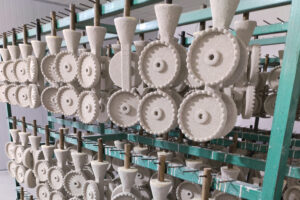Process of Investment Casting
Investment casting is a complex process that involves several steps to create high-quality castings. Each step is crucial in ensuring the final product meets the required standards. Let’s take a detailed look at the 12-step process of investment casting.
Step 1: Pattern Design
The first step in investment casting is pattern design. Based on the casting process design requirements, engineers create a pattern that will be used to create the mold for the casting.
Step 2: Pattern Manufacturing
Once the pattern design is finalized, the next step is pattern manufacturing. The pattern is manufactured according to the specifications mentioned in the design drawings. This can involve using steel, aluminum alloy, or other materials to create the pattern.
Step 3: Wax Pattern Manufacturing
In this step, a paste-like or liquid wax material is injected into the pattern using a hydraulic or pneumatic wax injection machine. This creates a wax pattern that replicates the shape of the desired casting.
Step 4: Assembly of Mold Modules
The wax patterns are then carefully assembled onto pre-made wax rods or gating systems to form mold modules. This step ensures that the wax patterns are securely attached and positioned correctly.
Step 5: Wax Removal
To enhance the coating properties of the wax patterns, the mold modules are immersed in a specialized degreasing solution. This solution removes any oil or release agents from the surface of the wax patterns.
Step 6: Shell Making
In this step, the mold modules are coated with a refractory material, often referred to as slurry. Then, a layer of sand, such as zircon sand, alumina sand, or silica sand, is applied on top of the slurry-coated modules. This process is repeated multiple times to create a certain thickness of a shell on the surface.
Step 7: Wax Melting
The shell molds, now with the wax patterns inside, are subjected to heating in steam or hot water. This heating process completely melts the wax patterns, leaving behind hollow cavities inside the shell molds.
Step 8: Shell Calcining
After the wax has been melted, the shell molds are placed in a furnace and subjected to high-temperature calcination. Calcination burns off any residual wax, volatile substances, and moisture present in the shells. This increases their permeability and high-temperature strength.
Step 9: Metal Pouring
Once the shell molds are fully calcined, they are ready for metal pouring. High-temperature liquid metal with the desired chemical composition is poured into the molds. The metal fills the cavities left by the melted wax patterns, taking their exact shape.
Step 10: Shell Removal and Cleaning
After the casting has solidified, the shells are removed from the metal castings manually or using a vibratory shell removal machine. The castings then undergo sand removal, gating removal, and other cleaning operations to remove any excess material and prepare them for further processing.
Step 11: Inspection of Castings
Quality control is crucial in investment casting. The castings must undergo thorough inspection to ensure they meet the required standards. This includes checking for dimensional accuracy, surface finish, and any defects that may affect the functionality of the final product.
Step 12: Post-Processing and Storage
Once the castings have passed the inspection, any necessary post-processing, such as heat treatment or machining, is performed. Afterward, the castings are ready to be stored or delivered to the customers.
Investment Casting Process Conclusion
In conclusion, the investment casting process involves various steps, from pattern design to the final inspection of the castings. Each step plays a crucial role in creating high-quality castings that meet the required standards. By following this detailed process, manufacturers can produce complex and intricate castings for a wide range of industries.







